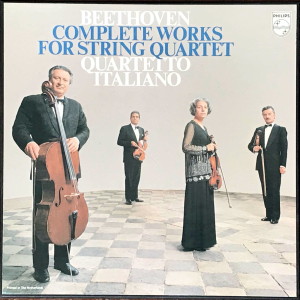 |
|
Philips
- 10 LPs - 6747 272
|
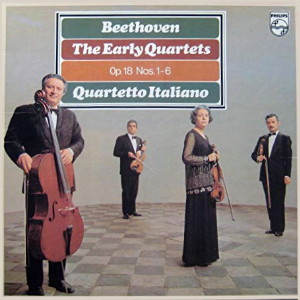 |
| Philips
- 3 LPs - 6998 025 |
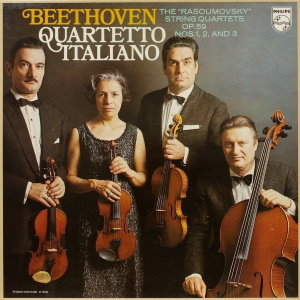 |
| Philips
- 3 LPs - 6998 017 |
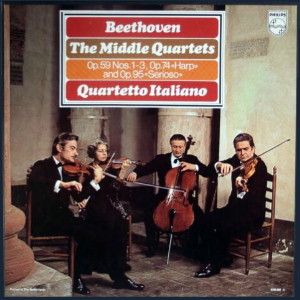 |
| Philips
- 3 LPs - 6703 085 |
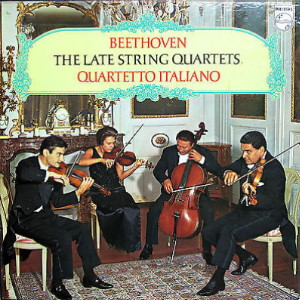 |
| Philips
- 4 LPs - 6707 008 |
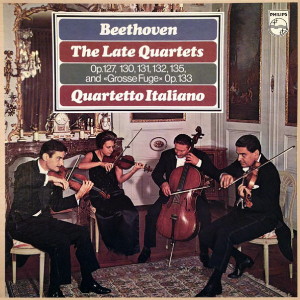 |
Philips
- 4 LPs - 6998 022
|
|
| COMPLETE WORKS FOR
STRING QUARTET |
|
|
|
|
|
|
|
| Ludwig van Beethoven
(1770-1827) |
|
|
|
|
|
|
|
|
THE
EARLY QUARTETS
|
|
|
|
|
| -
String Quartet No. 3 in D
major, Op. 18 No. 3 |
LP
1 - Philips
6500 181 - (p) 1972
|
|
26' 08" |
|
| -
String Quartet No. 1 in F
major, Op. 18 No. 1 |
LP
1 - Philips
6500 181 - (p) 1972
|
|
28' 05" |
|
| -
String Quartet No. 2 in G
major, Op. 18 No. 2 |
LP
2 - Philips
6500 646 - (p) 1975
|
|
25' 12" |
|
| -
String Quartet No. 4 in C
minor, Op. 18 No. 4 |
LP
2 - Philips
6500 646 - (p) 1975
|
|
25' 04" |
|
| -
String Quartet No. 5 in A
major, Op. 18 No. 5 |
LP
3 - Philips
6500 647 - (p) 1973
|
|
29' 26" |
|
| -
String Quartet No. 6 in B flat
major, Op. 18 No. 6 |
LP
3 - Philips
6500 647 - (p) 1973
|
|
27' 20" |
|
| THE
MIDDLE-PERIOD QUARTETS |
|
|
|
|
-
String Quartet No. 7 in F
major, Op. 59 No. 1 ("Rasoumovsky"
No. 1)
|
LP
4 - Philips
6747 139 - (p) 1974 |
|
40' 29" |
|
| -
String Quartet No. 8 in E
minor, Op. 59 No. 2 ("Rasoumovsky"
No. 2) |
LP
4/5 - Philips
6747 139 - (p) 1974 |
|
38' 19" |
|
| -
String Quartet No. 9 in C
major, Op. 59 No. 3 ("Rasoumovsky"
No. 3) |
LP
5 - Philips
6747 139 - (p) 1974 |
|
32' 01" |
|
| -
String Quartet No. 10 in E
flat major, Op. 74 "Harp" |
LP
6 - Philips
6500 180 - (p) 1971 |
|
32' 34" |
|
| -
String Quartet No. 11 in F
minor, Op. 95 "Serioso" |
LP
6 - Philips
6500 180 - (p) 1971 |
|
20' 22" |
|
THE
LATE QUARTETS WITH "GROSSE FUGE," OP.
133
|
|
|
|
|
| - String Quartet
No. 12 in E flat major, Op.
127 |
LP
7 - Philips
839 745 - (p) 1968 |
|
38' 04" |
|
| - String
Quartet No. 16 in F
major, Op. 135
|
LP
7 - Philips
839 745 - (p) 1968 |
|
25' 20" |
|
| - String
Quartet No. 13 in B flat
major, Op. 130 |
LP
8 - Philips
839 795 - (p) 1969 |
|
42' 50" |
|
- "Grosse
Fuge" in B flat major, Op.
133
|
LP
8 - Philips
839 795 - (p) 1969 |
|
18' 52" |
|
- String
Quartet No. 14 in C sharp
minor, Op. 131
|
LP
9 - Philips
802 915 - (p) 1969 |
|
42' 30" |
|
- String
Quartet No. 15 in A minor,
Op. 132
|
LP
10 - Philips
802 806 - (p) 1968 |
|
47' 10" |
|
|
|
|
|
QUARTETTO
ITALIANO
- Paolo Borciani,
Elisa Pegreffi, violino
- Piero Farulli, viola
- Franco Rossi, violoncello
|
|
|
|
|
|
Luogo e data
di registrazione |
|
Théâtre
Vevey, Vevey (Svizzera)
La
Salle des Remparts,
La Tour-de-Peilz (Svizzera)
Musica-Théâtre,
Salle de Musique, La-Chaux-de-Fonds
(Svizzera) |
|
|
Registrazione: live
/ studio |
|
studio |
|
|
Producer / Engineer |
|
Vittorio Negri |
Tony Buczynski, Willem van
Leewev, Ko Witteveen, Joost
Humeling, Gerard Janszen,
Frans von Dongen
|
|
|
Prima Edizione LP |
|
Philips | 6747
272 | 10 LPs | (Complete
Works for String Quartets)
Philips | 6998 025 | 3 LPs |
(The Early Quartets)
Philips
| 6998 017 | 3
LPs | (The
Middle-Period
Quartets)
Philips | 6703
085 | 3 LPs | (The
Middle-Period Quartets)
Philips
| 6707 008 | 4 LPs | The
Late Quartets)
Philips
| 6998 022 | 4
LPs | (The Late
Quartets) |
|
|
Prima Edizione CD |
|
Philips | 426 046-2
| 3 CDs (54' 02" - 47' 25" - 57'
28") | (c) 1989 | ADD | (The
Early Quartets)
Philips | 420 797-2 | 3 CDs (40'
29" - 58' 51" - 64' 35") | (c)
1989 | ADD | (The Midle-Period
Quartets)
Philips | 426
050-2 | 4 CDs (63' 45" - 62'
00" - 42' 22" - 47' 10") | (c)
1989 | ADD
| (The Late Quartets)
|
|
|
Note |
|
Ripubblicazioni
in cofanetto
dell'opera per
quartetto
d'archi di Beethoven.
|
|
|
|
|
BEETHOVEN:
COMPLETE WORKS
FOR STRING QUARTET
THE EARLY
QUARTETS
In considering
Beethoven's
artistic
creative
processes, a
certain area
might well be
reserved for
determining how
his own ideas
and personal
style were to be
reconciled with
the various
requirements of
difficult
musical genres.
It is quite
remarkable that
Count Apponyi’s
request to
Beethoven in
1795 to write a
string quartet
provided at
first only an
incentive to
write something
in a related
genre - in fact
the String
Quintet Op. 4.
The special
regard - not to
say respect -
for
quartet-writing
is made clear in
Beethoven’s
letter of July
13, 1808 to the
publishers
Breitkopf &
Härtel:
"...
I have
turned a single
sonata of mine
into a quartet
for stringed
instruments for
which people
were so
earnestly asking
me, and I know
for certain that
it would not be
easy for anyone
to do it better
than I
have done..."
In
the realm of the
string quartets
the spirit of
Mozart,
transmitted
through Haydn,
which Beethoven
had come to
Vienna to
receive, is
clearly
discernible.
Emanuel Aloys Förster
also exercised a
strong
influence. Some
of Beethoven’s
transcripts,
still extant,
make it clear
that he must
have made a
study in depth
in particular of
Mozart‘s Quartet
in A, K. 464 and
Haydn’s Quartet
in D, Op. 20 No.
4. The inclusion
of six quartets
in a single opus
number - in
Beethoven’s case
Op. 18 - is in
itself a general
indication of
Mozart and Haydn
as models. More
precisely,
Beethoven’s
Quartet Op. 18
No. 5 shows
clear affinities
with, if not
direct
reminiscences of
the Mozart
quartet
mentioned above
- in the common
key of A major
and, in the
overall
structure, the
reversal of the
middle movements
and the use of a
movement
consisting of a
theme and
variations, a
particularly
characteristic
form for
Beethoven
himself. The
minuet of
Beethoven’s
quartet reveals
very personal
characteristics;
the
heart-warming
Viennese
dance-tunes of
its trio are
reminiscent of
Haydn. Another
typical feature
is the way in
which an
insignificant
motif
obstinately
persists in
asserting itself
in the finale.
It
is, however,
within the
Quartet Op. 18
No.4 that we
find the oldest
stratum with
remains of the
Bonn period. Its
key of G minor
was equally
significant for
the Beethoven of
the early,
middle, and late
periods, but
here,
incidentally, it
has quite
different
emotional
overtones in the
first and last
movements. The
similarity (in
the first
movements) with
the Septet and
likewise with
the First
Symphony (in the
fugato
openings to the
second
movements)
points to
1798-1800 as the
period of
composition for
this work. It is
established that
the Quartet Op.
18 No. 3 was
composed first
and followed -
according to the
sketches found
by Gustav
Nottebohm - by
the Quartets
Nos. 1, 2, and
5.
As with the
fourth quartet,
we lack
corresponding
information
about the order
of composition
of the last
quartet. It is
undoubtedly the
most advanced;
it is in the
same key of B
flat major and
has the same
marking for the
first movement
as the Piano
Sonata Op. 22,
the two having
been partially
sketched out
together. There
is a hint of
later formal
developments in
the fact that
the first
movement clearly
yields pride of
place to the
scherzo, whose
exuberant
playfulness is
intended to
perplex both
players and
listeners with
its shifts of
emphasis
integrated in
masterly
fashion, and to
the unique
finale, whose
sub-title "La Malinconia”
(Melancholy) has
thrown up many
problems. The
impetuous
rhythmic drive,
which ultimately
dominates the
sombre and
restrained
introduction,
need not prevent
us from
regarding that
sub-title as
characterising
the whole
movement and not
merely the
beginning.
A critic of the
later Quartet
Op. 74, which he
bitterly
attacked, cast a
retrospective
eye over these
first six
quartets and
confirmed their
wealth
of imagination
and artistic
devices,
their
attractive
themes
appealing to
every shade of
feeling, and
the unity and
firmly
consistent
character of
every
movement,
worthy of
comparison
with the
masterpieces
of Haydn and
Mozart.
THE MIDDLE-PERIOD
QUARTETS
To the period
after the
completion of
the “Eroica"
Symphony, the
"Waldstein”
Sonata, Op.
53, and the
“Appassionata”
Sonata, Op. 57
belong the
three quartets
of Op. 59,
dedicated to
Count Rasoumovsky,
the Russian
ambassador to
the Austrian
court,
well-known in
contemporary
Vienna as a
considerable
art collector,
a very
competent
string-player,
and a keen
amateur of
music. While
the
introduction
of Russian
folk-tunes in
the first and
second
quartets may
be regarded as
no more than a
slight
courtesy
towards the
dedicatee, the
systematic
pursuit of
individual
aims in the
composition as
a whole
certainly
deserves
attention;
this is clear
in the first
public notice:
“Three new,
very long and
difficult
string
quartets by
Beethoven...
are also
attracting the
attention of
all
connoisseurs.
They are
profound in
thought and
splendidly
worked out,
but not
generally
comprehensible
- with the
possible
exception of
the third in C
major, which
must win over
every
knowledgeable
amateur of
music by its
individuality,
melody, and
harmonic power."
Through the
second movement
of the Quartet
in E minor, Op.
59 No. 2 there
blows a breath
somewhat
reminiscent of
the "Heiliger
Dankgesang eines
Genesenen an die
Gottheit” (Hymn
of gratitude
from a
convalescent to
the Divinity)
from the late A
minor Quartet,
Op. 132.
Considering the
profound and
heart-felt theme
of the
chorale-like
movement in the
E minor Quartet,
it hardly needs
the addition of
the special
marking: Si
tratta questo
pezzo con molto
di sentimento.
According to
Czerny it is
supposed to have
occurred to
Beethoven once
when he was
contemplating
the starry sky
and meditating
on the music of
the spheres.
Contemporary
opinion
immediately
accepted the
electrifying
virtuoso and yet
accessible
qualities of the
third quartet,
which correspond
to those of
piano sonatas
composed
contemporaneously
or shortly
before. As a
consequence of
the unmistakable
basic rhythmic
impulse, an Andante
con moto quasi
allegretto
has replaced the
normal Adagio
which might have
slowed the
impetus
excessively.
Similar
considerations
may have led to
the choice of a
fugal finale and
indeed to the
free extension
of what is a
closely
organised form.
The original and
special quality
in Beethoven is
increasingly
crystallised as
an
intensification
of expression.
His letter of
November 1, 1806
to the Scottish
amateur of
music, George
Thomson,
indicates the
possibilities
available to him
of applying his
art on different
levels. He says:
“I shall strive
to make the
compositions
easy and
agreeable as far
as I
can, and insofar
as I can
reconcile this
with that
loftiness and
originality of
style which,
according to
your own
testimony,
characterise my
works to their
advantage, and
from which I
shall never
depart."
However,
Beethoven’s main
stream of
composition
followed other
laws. This is
how the reporter
of the Leipzig
“Allgemeine
Musikalische
Zeitung"
interpreted the
E flat Quartet,
Op. 74 in his
own fashion:
“The composer
has here devoted
himself
uncompromisingly
to the most
remarkable and
strange
conceptions of
his original
imagination, has
fantastically
woven together
the most
disparate
elements, and
has treated
almost all of
them witn such
profound and
difficult art
that even the
lighter and more
pleasing details
have simply
foundered in the
ambient gloom."
He concludes
severely by
saying that he
could not wish
instrumental
music to lose
its way in this
fashion; that
the purpose of
the string
quartet as a
genre could
surely not be to
commemorate the
dead or to
describe the
feelings of
those in
despair, but
rather to raise
the listeners
spirits by the
gentle and
beneficent play
of the
imagination. A
confusion of
dissonances
towards the end
of the Adagio,
a virtually free
tantasia in the
Allegro
of the first
movement,
war-like dances,
as it were, of a
savage people in
the third
movement, and a
finale
consisting of
variations which
are profound and
original rather
than pleasing -
all these
elements were
here marshalled.
The sub-title
“Quartetto
serioso" is to
be found in the
manuscript of
the F minor
Quartet, Op. 95.
An
attempt has been
made to relate
the "serioso"
to Beethoven’s
offer of
marriage to
Therese
Malfatti, which
was refused.
Hugo Riemann
began a
discussion of
this work by
saying: "The
first movement
is perhaps the
most brusque
that Beethoven
has ever
written." He
here refers to a
certain motif
which occurs
about 50 times
in the mere 151
bars comprising
the first
movement.
Beethoven was
perfectly aware
ofthe nature of
the work. In
mid-October he
explained in a
letter to George
Smart in London
that the quartet
was written only
for a small
group of
connoisseurs and
was never
intended to be
played in
public. Written
as early as
1810, it was
published only
in December
1816. The
dedicatee,
Beethoven’s
friend Nikolaus
von Zsmeskall
was a
professional - a
very competent
cellist who
himself left no
fewer than 14
original
quartets.
THE LATE
QUARTETS
The last and
ripest phase, in
which the
quartet form has
its strongest
individual
significance and
in which
Beethoven’s
language,
refined by
experience, is
at its most
spiritual,
begins with the
Quartet in E
flat, Op. 127.
Here, in the
first movement,
the cantabile
style, indeed "infinite
melody" in the
Wagnerian sense,
predominates.
The almost
religious
meditation of
this movement is
intensified in
the subsequent
movement (Adagio
ma non troppo
e molto
cantabile)
to a
transcendental
and fervent
transfiguration.
In
the
bridge-passage
to the theme and
variations we
find a structure
absolutely
peculiar to
Beethoven. The
scherzo, one of
the greatest,
and a work of
genius, takes
its place beside
the incomparable
scherzo of the
Ninth Symphony,
work on the
ending of which
interrupted work
on the quartet
for months at a
time. The finale
(in the form of
a rondo with
free episodes)
gives an overall
impression of
serenity, but
ends misted in
obscurity - in a
mood removed, as
it were, from
earthly things.
The Mainz
publisher
Schott, who
reckoned this
work to be the
summit of
instrumental
music, could
still not
refrain from
pointing out
certain
difficulties. In
a letter of the
period Beethoven
complained of
the scandal of
general public
taste being far
inferior in the
artistic world
to that in
private circles.
It
is also worth
noting that
success came
only with the
second
performance, in
which Joseph Böhm
replaced lgnaz
Schuppanzigh as
leader.
The last four
quartets all
belong to the
years 1825-26,
though in fact
composed in a
different order
from that
indicated by the
opus numbers.
The A
minor Quartet,
Op. 132, dates
from February to
the end of July
1825 and the B
flat Quartet,
Op. 130, with
the "Grosse
Fuge"
(subsequently
issued
independently as
Op. 133) as
finale, from
July to
November. In
the first six
months of 1826
there followed
the C sharp
minor Quartet,
Op. 131, and
from July to
October the F
major Quartet,
Op. 135.
Finally, the
period from
September to the
beginning of
November
produced the
definitive
finale of the B
flat Quartet,
Op. 130, which
at the same time
represents
Beethoven’s last
complete major
composition.
(For the
listener`s
convenience,
both finales are
presented in
these recordings
on Side 16, with
the “Grosse
Fuge" taking
pride of place.)
Ii
is not only in
his late works
that
Beethoven, despite
the narrow
confines in
which he moved,
burst the bounds
of traditional
dimensions not
only by
increasing the
number of
movements but by
electing to
compose such a
colossal finale
as the "Grosse
Fuge" (though
later yielding
to the advice of
friends). Even
the "Waldstein"
Sonata started
life with an
extended middle
movement which
was replaced by
a Short "Introduzione"
to the finale
and published
separately as
the "Andante
favori."
According to a
report by his
friend Karl
Holz, Beethoven
is supposed to
have wept tears
of sorrow as he
composed the
Cavatina: "He
confessed to me
that his own
music had never
yet produced
such an
impression on
him, and that
even to
re-experience it
cost him fresh
tears."
We can,
incidentally,
judge of the
labour which
Beethoven
undertook by the
sketches which,
in the case of
the C sharp
minor Quartet
alone, occupy
three times the
volume of the
fair copy. In
spite of
everything,
however, he was
not
uhremittingly in
deadly earnest,
either in music
or in words;
lack of humour
is rather a
characteristic
of his
contemporaries,
who took the
facetious remark
on the
proof-copy: "Filched
and put together
from various
sources, here
and there," at
its face-value
and thereby
occasioned a
corresponding
explanatory
letter.
The inscription
on the third
movement of the
Quartet in A
minor, Op. 132-
“Heiliger
Dankgesang eines
Genesenen an die
Gottheit in der
lydischen
Tonart" (Hymn of
gratitude from a
convalescent to
the Divinity in
the Lydian mode)
refers to a
serious illness
which caused an
interruption of
work in the
spring of 1825.
At the rehearsal
on September 7,
1825, the
solemn, and
pious mood of
this movement is
supposed so to
have affected
Johann
Woltmayer, the
rich cloth
merchant and
patron of the
arts, that he
wept like a
child.
Work on the
Quartet in F,
Op. 135, lasted
until late
autumn of 1826,
since Beethoven
had undertaken
the fateful
journey to his
brother’s
property near
Gneixendorf,
from which he
was to return to
Vienna with his
mortal illness.
The most
impressive
contemporary
document
concerning
Beethoven’s late
style of quartet-writing
is an unusually
extensive notice
of the C sharp
minor Quartet,
Op. 131, which
Friedrich
Hochlitz
published in the
Leipzig "Allgemeine
Musikalische
Zeitung" on July
23, 1828, more
than a year
after
Beethoven’s
death. Rochlitz
went so far as
to doubt, though
with
unmistakably
cautious
reserve, the
capacity of the
aging master to
compose at all
since, almost
completely
devoid of
hearing, he
could at the end
only have lived
his own inner
life. He found
fault chiefly
with
introspective,
disconnected
combinations,
with themes too
overlaid with
instruments
weaving
variations, or
too violently
alternating
figurations
making it almost
impossible to
distinguish the
melody. The
themes
themselves he
found frequently
quite strange,
the modulations
acute to a
bizarre degree,
and the time
signatures
changing too
abruptly. On the
other hand, he
conceded that
these works
demanded
intelligent and
repeated
hearings and
above all an
appropriate
interpretation.
However,
Beethoven’s
greatness was
unassailable as
far as he was
concerned; nor
was he certain
whether this
last period
should not after
all be regarded
as a
well-considered
stylistic
development.
“Beethoven did
not
compromise...
least of all did
he compromise in
his last
works... He has
been called the
inventor of his
time musically
speaking, and
that he is
indeed. When
scarcely more
than a youth he
was already
producing works
which were
original, which
belonged to him
alone, which
could only have
come from him.”
It
almost seems
as if
Rochlitz, who
anyway held
Beethoven in
high esteem,
suspected that
the composer
might
ultimately be
proved to be
in the right
despite such
criticism; at
any rate he
considered it
appropriate to
quote
Lichtenberg’s
well-known
saying,
obviously in
Beethoven’s
favour: "If
a head and a
book are
knocked
together and
there is a
hollow sound,
must it always
come from the
book?"
HANS
SCHMIDT
Beethoven-Archiv,
Bonn
Translated
by Francis
Català
NOTE FOR
THE
SCORE-READERS
The basic
score for the
Quartetto Italiano`s
performances
of the late
string
quartets was
the Universal
Edition (based
on the first
editions of
the original
versions).
However, in
the violin
parts of the
substitute
finale of Op.
130 (Side 16),
at bars 98 and
99 (the poco
ritardando
after the
double-bar of
the
exposition),
the F sharp of
the Peters
edition has
been preferred
to the F
natural of
Universal.
QUARTETTO ITALIANO
The Quartetto
Italiano is
deservedly one
of the most
renowned
quartets of
our time. It
was as long
ago as 1945,
soon after
completing
their studies,
that Paolo
Borciani,
Elisa
Pegreffi,
Piero Farulli,
and Franco
Rossi,
resisting the
tempting
promise of
individual
careers as
soloists,
decided to
pool their
youthful
enthusiasm and
musical talent
and devote
themselves to
the difficult
but satisfying
art of playing
chamber music
really well.
By 1947 the
group had
established a
firm
reputation in
the musical
press and
begun giving
concerts
outside Italy.
In1951
they visited
the United
States for the
first time,
and it was
soon apparent
that their
devotion to
their music
and the
impeccable
standards of
performance
they had set
for themselves
were earning
them fame as
well as
satisfaction.
Over the years
since 1945
they have
remained
together, a
rare example
of teamwork in
music.
To list the
group`s
wide-ranging
activities in
more than 30
years is
pointless:
they have done
everything one
might expect
of one of the
world’s finest
quartets. They
have given
hundreds of
concerts all
over Europe
and in the
United States;
they are
regular
participants
in the
chamber-music
concours of
many
countries; and
they have
played and are
in constant
demand at the
world`s great
music
festivals.
Outside the
concert
circuit the
members of the
quartet teach
chamber music
at both the
Royal Academy
of Music in
Stockholm and
the
Conservatoire
in Vienna.
In
addition to
the many words
of praise
bestowed on
them - after
their first
concert in New
York, Virgil
Thomson, the
distinguished
critic of the
"New
York Herald
Tribune,"
called them
“the finest
quartet,
unquestionably,
that our
century has
known” - they
have been
publicly
honoured by
the President
of Italy as a
more tangible
recognition of
their
outstanding
artistic
services over
the years to
Italy in
particular and
the world of
music in
general.
|
|
|